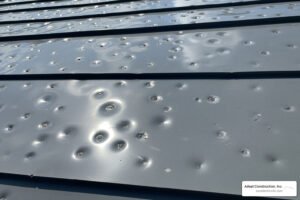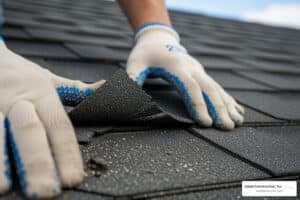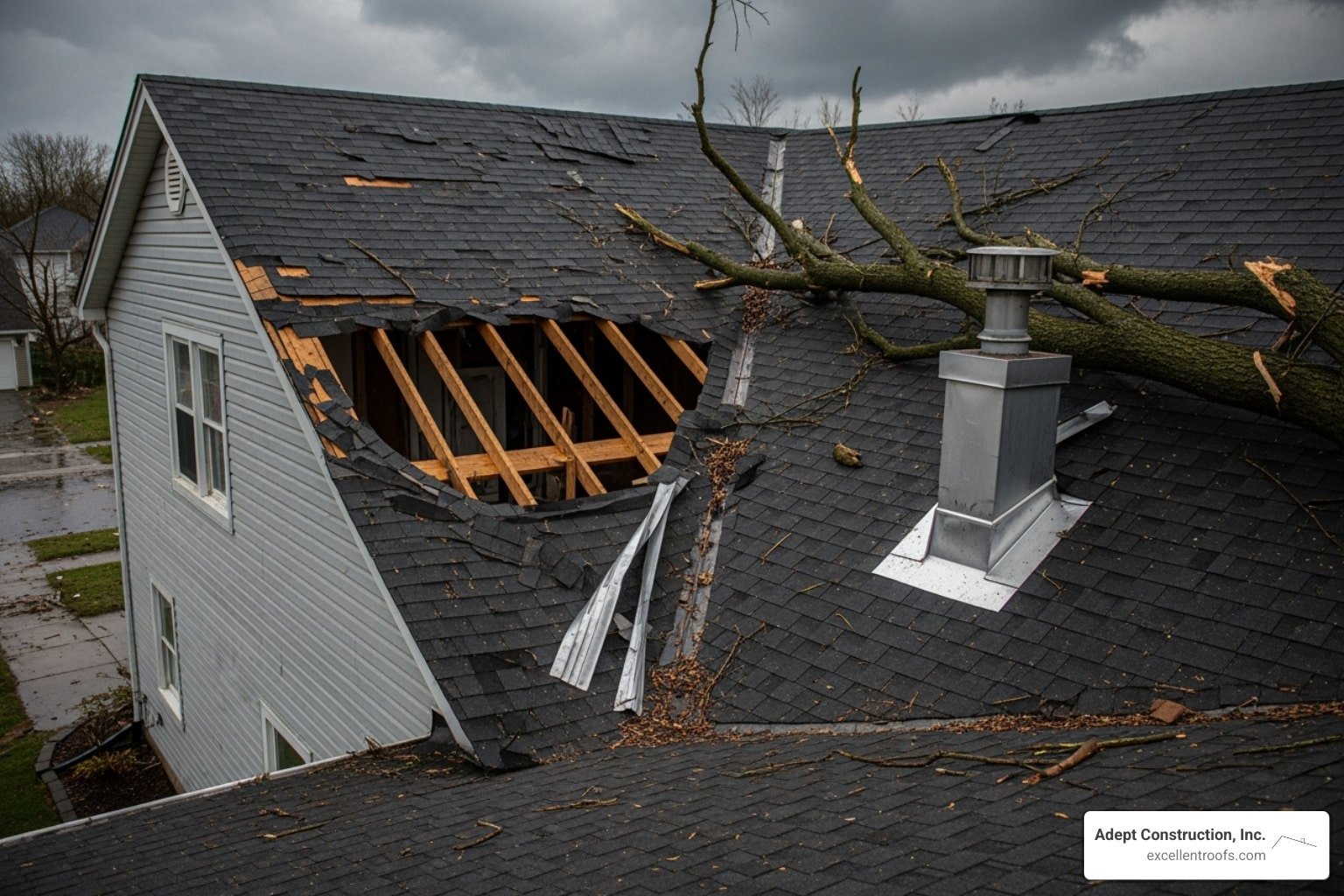
Why Storm Damage Roof Repair Requires Immediate Action
Storm damage roof repair is one of the most urgent home maintenance issues you’ll face after severe weather. When high winds, hail, or falling debris compromise your roof, any delay increases the risk of water infiltration, structural issues, and costly interior damage. At Adept Construction, Inc., we are committed to providing excellent roofing solutions that protect your home and peace of mind.
If you need immediate help, follow these steps:
- Prioritize safety: Stay off the roof and check for downed power lines.
- Document everything: Take photos and videos of all visible damage from the ground.
- Make temporary repairs: Cover large holes with tarps to prevent water entry if it’s safe to do so.
- Contact your insurance: Report the damage as soon as possible to start your claim.
- Hire a professional: Contact a licensed contractor for a full damage assessment and a detailed repair plan for your storm damage roof repair.
After a storm, hidden damage can lead to leaks, mold, and compromised structural integrity. While the average cost of roof repair ranges from $379 to $1,755, extensive damage may require a full replacement starting at $7,500. Most homeowners insurance policies cover storm damage, but your policy type—Actual Cash Value vs. Replacement Cost Value—will significantly impact your out-of-pocket expenses.
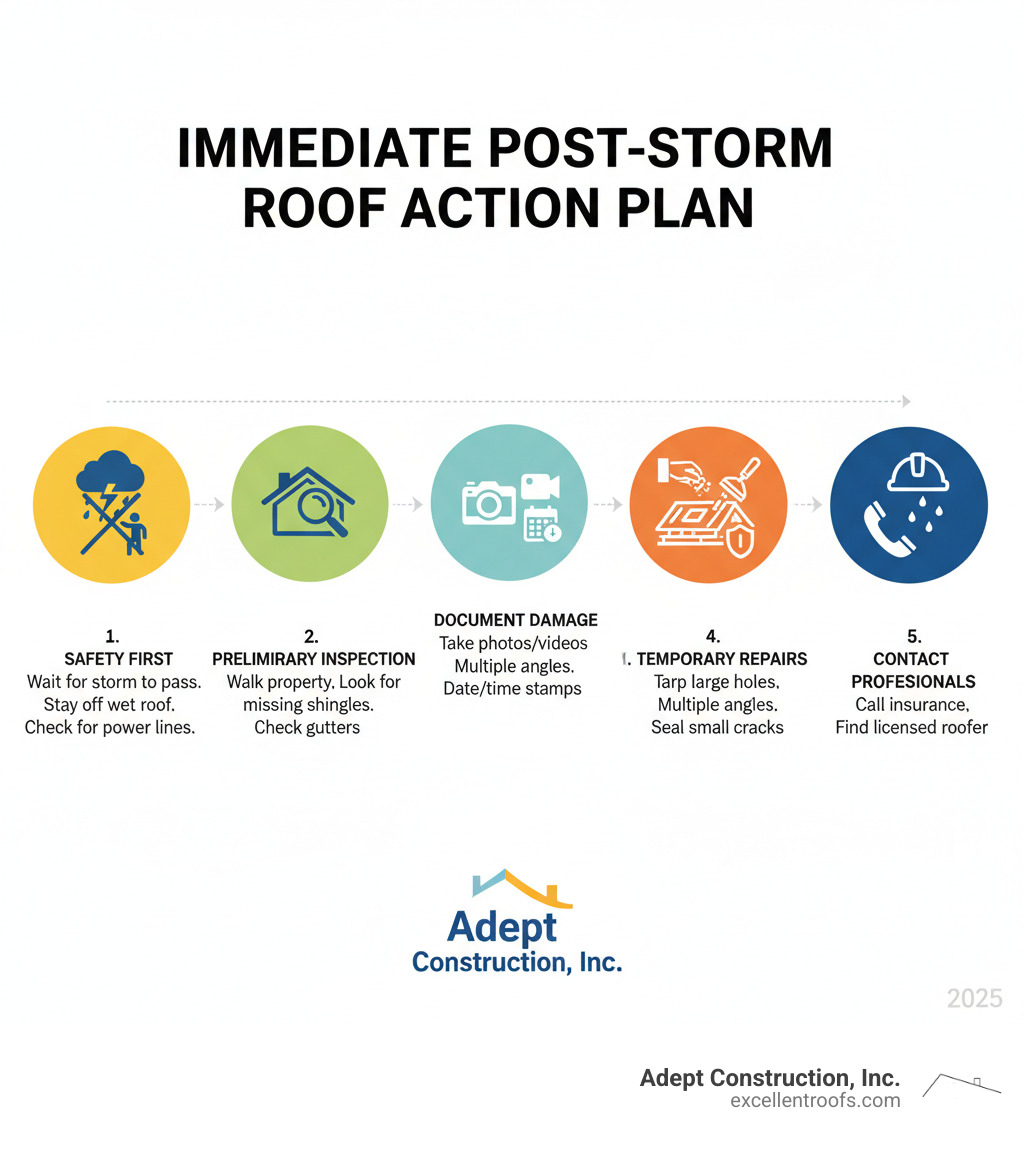
Your Immediate Post-Storm Action Plan
The moments after a storm are critical. It’s natural to feel overwhelmed, but taking the right steps can protect your home and minimize further damage. Here’s what to do right now.

Prioritize Safety Above All Else
Your safety is more important than any roof. Before inspecting for damage, follow these precautions:
- Wait for the storm to pass completely. Do not go outside during high winds, heavy rain, or lightning.
- Stay off the roof. Wet roofs are dangerously slippery, even for professionals.
- Watch for downed power lines. If you see any wires near your home, stay far away and call your utility company immediately.
- Look for structural threats from the ground. If you see a sagging roofline or large holes, your home may be unsafe. In major disaster situations, FEMA provides essential disaster recovery resources.
Conduct a Preliminary Inspection
Once it’s safe, perform a ground-level inspection to assess the situation. You can spot a surprising amount of damage without a ladder.
- Walk your property: Look for fallen tree branches, pieces of shingles, or other debris.
- Examine the roof: From the ground, look for missing, curled, or creased shingles, especially at the edges and ridges.
- Check your gutters: A large amount of asphalt granules in your gutters is a red flag for hail damage.
- Inspect the attic: If you can do so safely, look for water stains on the insulation or ceiling. Any visible daylight through the roof boards indicates a serious breach. For a complete guide, see our article on the top signs your roof needs immediate repair after a storm.
Document the Damage Thoroughly
Thorough documentation is crucial for a smooth insurance claim. Think of yourself as a detective building a case.
- Take photos and videos: Capture wide shots of the entire roof and close-ups of specific damage from multiple angles.
- Document the storm’s severity: Photograph fallen debris and any hailstones next to a coin or ruler to show their size.
- Note the date and time: This timeline helps prove when the damage occurred.
- Save all receipts: Keep records of any purchases for temporary repairs, such as tarps or plywood, as these may be reimbursable.
Make Emergency Temporary Repairs
If water is actively entering your home, temporary repairs can prevent further damage until a professional arrives. Your safety, however, remains the top priority.
- Tarp large holes: If you have large areas of missing shingles and more rain is coming, securing a tarp can be an effective stopgap. Only attempt this if you can do so safely.
- Use roofing cement for small cracks: A small dab of roofing cement can temporarily seal minor cracks or lifted shingle tabs.
These are temporary measures to stop water intrusion. They are not a substitute for professional storm damage roof repair. Now that you’ve taken these critical first steps, it’s time to bring in an expert. Contact us today for a free estimate—we’re here to help.
Identifying the Type and Severity of Roof Damage
Different types of severe weather leave unique signatures on your roof. Recognizing these signs helps you communicate effectively with contractors and insurance adjusters.

How to Spot Wind Damage
Even winds below hurricane strength can cause significant problems. While hurricane-force winds are classified as 74 mph or greater, strong gusts can lift shingles and create openings for water. Look for these common signs of wind damage:
- Missing shingles: Bare patches on your roof are the most obvious sign.
- Lifted or curled shingle edges: Wind can break the sealant bond, prying up the corners of shingles and making them vulnerable.
- Creased or torn shingles: Shingles that have been bent back by the wind lose their waterproofing ability.
- Damaged flashing: Wind often tears or bends the metal flashing around chimneys, vents, and skylights, creating a direct path for water.
Recognizing Hail and Debris Impact
Hail damage is often subtle but can be very destructive over time. Our guide on How to Spot Hail Damage on Your Roof offers a detailed walkthrough. Key indicators include:
- Circular bruises or dents: Hailstones create impact marks that compromise the shingle’s integrity.
- Loss of asphalt granules: Hail knocks off the shingle’s protective top layer. Look for these granules in your gutters.
- Cracks in shingles: Older, more brittle shingles can crack upon impact.
- Punctures from debris: Fallen tree limbs can pierce the roof deck, creating obvious holes that require immediate attention.
Signs Your Roof Needs Replacement, Not Just Repair
Sometimes, storm damage roof repair isn’t enough, and a full replacement is the more cost-effective solution. You may need a replacement if you notice the following:
- Widespread damage: If over 30% of your roof is damaged, replacement is often more practical than extensive patching.
- Advanced age: If your asphalt shingle roof is over 20 years old, it’s already near the end of its lifespan, and storm damage may be the final straw.
- A sagging roof deck: This is a major red flag indicating structural issues, likely from prolonged water damage.
- Multiple existing leaks: If your roof was already failing before the storm, a replacement is the only long-term solution.
- High repair costs: When repair estimates approach or exceed 50% of the replacement cost, investing in a new roof provides better value, a full warranty, and peace of mind. Our team offers expert guidance on roof replacement in Downers Grove to help you make an informed decision.
Navigating the Insurance Process for Storm Damage Roof Repair
Dealing with an insurance claim can be stressful, but understanding the process puts you in control and improves your chances of a fair settlement.
Understanding Your Homeowner’s Insurance Policy
Your insurance policy is your financial safety net. To use it effectively, follow these steps:
- Contact your agent promptly: Most policies require timely reporting of damage. Have your policy number ready when you call.
- Review your storm coverage: Understand what your policy covers regarding wind, hail, and fallen trees. Knowing your policy’s limits and exclusions prevents surprises.
- Know your deductible: This is the amount you pay out-of-pocket before your insurance coverage kicks in. Understanding this figure helps you decide whether to file a claim for minor damage. For more details, our article on Roof Damage Insurance Claims offers a step-by-step guide.
The Difference Between ACV and RCV Policies
The type of policy you have—Actual Cash Value (ACV) or Replacement Cost Value (RCV)—dramatically affects your payout for storm damage roof repair. An RCV policy is generally preferred as it covers the full cost to replace your roof with new materials, whereas an ACV policy only pays for the depreciated value of your old roof.
| Feature | Actual Cash Value (ACV) Policy | Replacement Cost Value (RCV) Policy |
|---|---|---|
| Payout Basis | Pays the depreciated value of your roof at the time of loss (original cost minus depreciation). | Pays the cost to replace your roof with a new one of similar quality and kind, without deduction for depreciation. |
| Initial Payout | Typically a single payment for the depreciated value. | Often a two-part payment: an initial payment for the ACV, followed by a second payment (recoverable depreciation) once repairs/replacement are complete and receipts are submitted. |
| Your Cost | You cover the difference between the depreciated value and the actual replacement cost, plus your deductible. | You pay your deductible upfront. The insurance then covers the full replacement cost, minus your deductible, in one or two installments. |
| Benefit | Lower premiums. | Higher payout, ensuring your roof is replaced to its original condition without significant out-of-pocket expenses beyond the deductible. Provides “new for old” coverage. |
| Example | Roof replacement costs $15,000. Depreciated value is $5,000. Deductible is $1,000. Insurer pays $4,000. You pay $11,000. | Roof replacement costs $15,000. Deductible is $1,000. Insurer pays $14,000 (often in two checks). You pay $1,000. |
If you have an RCV policy, understanding recoverable depreciation is key. You will receive a second check for the depreciated amount only after you provide proof that the work has been completed. Keep all contracts and receipts from your roofer to claim this final payment.
What to Do If Your Claim is Denied
A denied claim isn’t necessarily the final word. Here’s how to challenge the decision:
- Request the denial in writing: Insurance companies are required to provide a reason for their decision.
- Review your policy and documentation: Compare the insurer’s reasoning with your policy language and the evidence you collected.
- Get a second opinion: Schedule an inspection with a trusted roofer who specializes in storm damage assessment and repair. A professional report can identify damage the adjuster missed.
- File an appeal: Submit your contractor’s assessment and any additional evidence to your insurance company. Be persistent and professional.
If your area was declared a federal disaster zone, you might qualify for other aid. Visit disasterassistance.gov to explore your options.
Hiring a Pro for Your Storm Damage Roof Repair
Choosing the right contractor for storm damage roof repair is the most critical decision you’ll make in this process. A qualified professional ensures a quality repair and provides peace of mind.
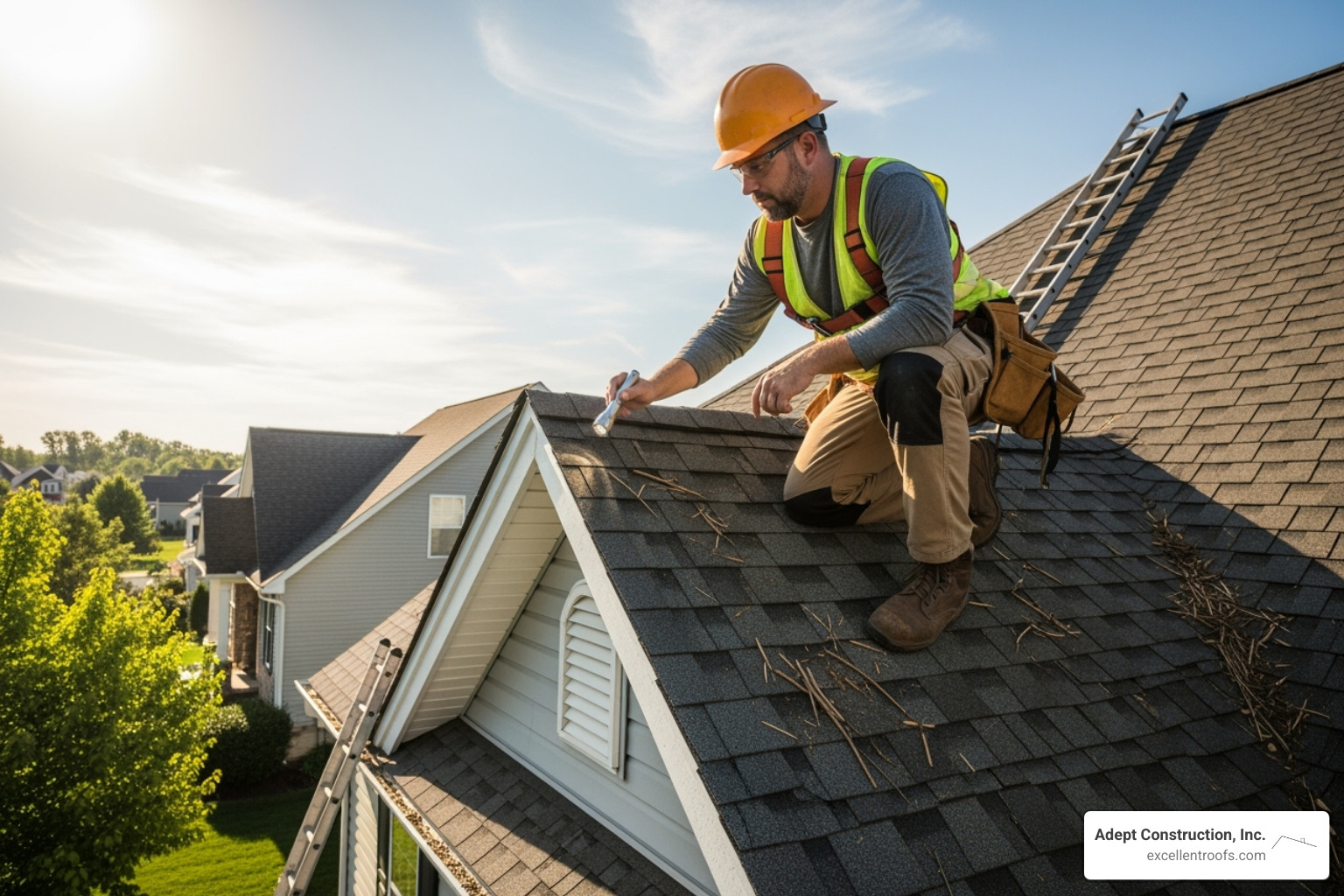
How to Choose a Reputable Roofing Contractor
After a storm, be wary of unscrupulous operators. To find a trustworthy team, follow these steps:
- Verify local license and insurance: This protects you. Ask for proof of liability and worker’s compensation coverage. Adept Construction, Inc. is fully licensed and insured in Illinois.
- Check online reviews: Look for consistent positive feedback on Google, Yelp, and the Better Business Bureau (BBB).
- Ask for local references: A reputable contractor will gladly provide references from recent projects in your area.
- Beware of “storm chasers”: These out-of-town contractors often perform shoddy work and disappear. Always choose a local company with an established presence in communities like Naperville, IL and Downers Grove, IL.
- Get a detailed written contract: The contract should outline the scope of work, materials, timeline, payment schedule, and warranty information. Never sign a blank contract.
The Long-Term Consequences of Ignoring Roof Damage
Delaying roof repairs is a gamble that can lead to far more expensive and dangerous problems. The consequences include:
- Progressive water damage: A small leak can spread, damaging ceilings, walls, and even your home’s foundation.
- Structural rot: Persistent moisture can cause wood rot in your roof deck and rafters, compromising your home’s structural integrity.
- Toxic mold growth: Damp environments are a breeding ground for mold, which can cause serious health issues.
- Higher energy bills: Wet insulation loses its effectiveness, forcing your HVAC system to work harder and driving up utility costs.
- Decreased home value: A damaged roof detracts from curb appeal and will be a major issue when you decide to sell.
What to Expect During the Professional Repair Process
Knowing the steps can reduce anxiety. Here’s what to expect when you partner with Adept Construction, Inc.:
- Consultation and Estimate: We perform a thorough inspection and provide a detailed, transparent estimate with no pressure.
- Material Selection: We help you choose the best materials for your budget and needs, then schedule delivery.
- Property Protection: We use tarps and plywood to protect your landscaping, driveway, and other vulnerable areas.
- Tear-Off and Installation: Our experienced team removes old materials, inspects the underlying deck, and installs your new roof with precision, adhering to all building codes.
- Site Cleanup: We clean the site daily and use magnetic sweepers to remove stray nails upon completion.
- Final Walkthrough: We conduct a final inspection with you to ensure your complete satisfaction and provide all warranty information. For details on our local services, see our pages on roof repair in Naperville, IL and roof repair in Downers Grove, IL.
Contact us today to schedule your free, no-obligation inspection.
Proactive Measures to Minimize Future Storm Damage
The best time to prepare for the next storm is now. Proactive maintenance and quality materials are the best defense against severe weather and costly storm damage roof repair.
The Importance of Routine Roof Maintenance
A well-maintained roof not only lasts longer but also performs better during a storm. Key maintenance steps include:
- Schedule annual professional inspections: A professional can spot small issues like loose shingles, worn sealant, or compromised flashing before they become major problems. Our guide on How Often Do You Need a Roof Inspection explains the ideal schedule.
- Keep gutters clear: Clogged gutters cause water to back up under shingles and overflow, leading to water damage. Regular cleaning is a simple, preventative measure.
- Address minor issues immediately: A single missing shingle or a small crack is an entry point for water. Prompt, minor repairs are far more affordable than emergency repairs later.
Upgrading to Storm-Resistant Roofing Materials
If you’re replacing your roof, consider upgrading to materials designed to withstand severe weather. While the upfront cost may be higher, the long-term protection and potential insurance discounts are often worth it.
- Class 4 impact-resistant shingles: These are the gold standard for hail protection. They are tested to withstand the impact of a 2-inch steel ball dropped from 20 feet. Many insurance companies offer premium discounts for homes with Class 4 shingles.
- Metal roofing: Able to withstand winds up to 140 mph and highly resistant to hail, metal roofs are an excellent long-term investment, lasting 40-70 years.
- Composite and cedar shake roofing: High-quality composite shingles offer the look of slate or cedar with superior durability. Cedar shake provides natural beauty but requires proper installation and maintenance to maximize storm resistance.
Our article on How to Choose the Best Material for Your Roof can help you weigh the pros and cons of each option. Taking these proactive steps can significantly reduce your home’s vulnerability to storm damage. Contact us for a free estimate to discuss which preventive measures make the most sense for your home and budget.
Frequently Asked Questions about Storm Damage Roof Repair
Here are answers to the most common questions we receive from homeowners dealing with the aftermath of severe weather.
How much does storm damage roof repair cost?
The cost of storm damage roof repair varies widely based on several factors. While minor repairs average between $379 and $1,755, the final price depends on:
- The extent of the damage: Replacing a few shingles is much cheaper than repairing widespread hail damage.
- Your roofing materials: Standard asphalt shingles are less expensive to repair than materials like slate or metal.
- Your location: Labor and material costs differ by region.
- Your insurance coverage: A Replacement Cost Value (RCV) policy will significantly reduce your out-of-pocket expenses compared to an Actual Cash Value (ACV) policy.
A full roof replacement typically starts at $7,500 for asphalt shingles. For an accurate price, a professional inspection is essential.
How long does a roof repair take after a storm?
The timeline depends on the scope of work.
- Minor repairs (e.g., replacing a few shingles) can often be done in a few hours to one day.
- Extensive repairs may take one to three days.
- A full roof replacement typically takes two to five days, depending on the roof’s size, complexity, and weather conditions.
We work efficiently without sacrificing quality and keep you informed throughout the process.
Can I perform the roof repairs myself?
While DIY temporary fixes like tarping a hole are acceptable, permanent storm damage roof repair should always be left to professionals for several key reasons:
- Safety: Working on a damaged roof is extremely dangerous. Falls are a leading cause of serious injury.
- Warranties: DIY repairs can void both your roofing material warranty and your homeowner’s insurance policy.
- Building codes: Professionals ensure all work complies with local building codes, which is crucial for safety and your home’s value.
- Expertise: A professional can identify hidden damage and ensure repairs are done correctly to prevent future leaks and more costly problems. Trusting experts who specialize in storm damage restoration protects your investment.
Secure Your Home with Professional Roof Repair
When a storm damages your roof, the clock starts ticking. Delaying repairs increases the risk of water damage, structural problems, and higher costs. You now know how to inspect for damage, document it for insurance, and choose the right materials. The final step is choosing the right partner to restore your home’s primary shield.
At Adept Construction, Inc., we are a family-owned company based in Downers Grove, Illinois, dedicated to serving our neighbors. We aren’t storm chasers who disappear after the work is done; we are part of your community and will be here long after your roof is repaired.
Storm damage roof repair is about restoring your peace of mind. With nearly three decades of experience, our team works to explain your options clearly and helps you steer the insurance process. Our reputation is built on quality workmanship and the referrals from satisfied homeowners who trust us with their most valuable asset.
Don’t let storm damage compromise your family’s safety. Water intrusion doesn’t wait, and neither should you when it comes to protecting your home.
Contact us today for a free, no-obligation estimate. Let our experts assess your damage and provide the professional storm damage restoration your home deserves.



